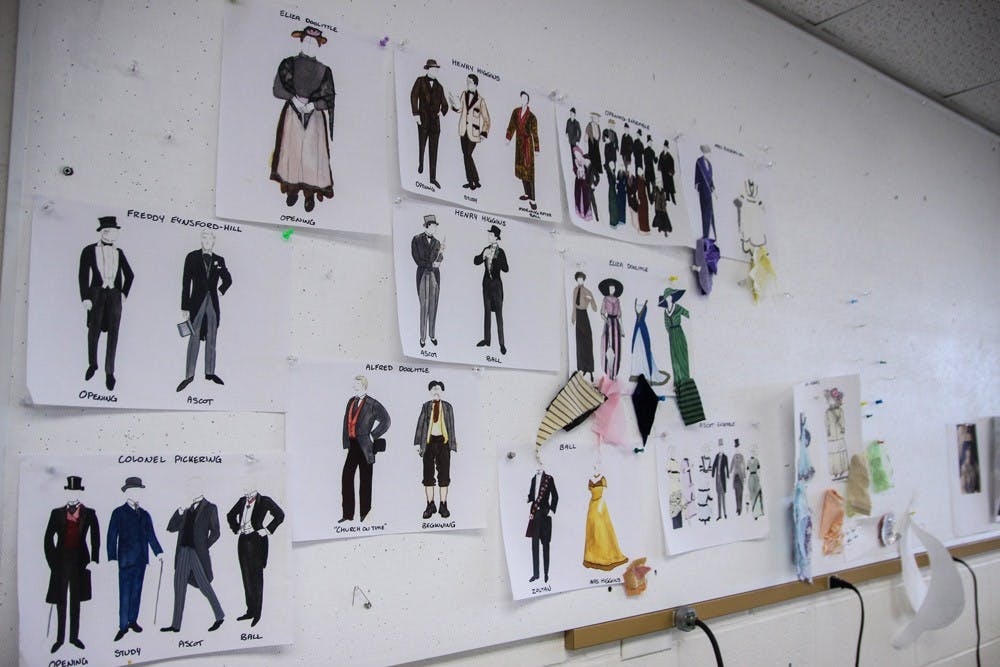Leah Berst believes “My Fair Lady” is a fairytale. Throughout the play, her character Eliza Doolittle wears several decadent costumes fit for a princess.
Berst, a senior musical theater major, said the costumes help her embody the iconic Eliza.
“These costumes are period costumes and the show is set in 1912, so the authenticity of the character shines with the costumes…the costumes bring the reality of the time period into your body and reflect the character’s lifestyles,” Berst said.
UB students in the Theatre & Dance Department will present “My Fair Lady” from April 28-30 and May 5-7 at the Center for the Arts Drama Theatre. The play is set in 1912 and tells the classic rags-to-riches tale of Eliza Doolittle, a Cockney flower girl who takes speech lessons from Professor Henry Higgins in order to pass as a high society lady.
Bethany Kasperek, a senior theatre design technology major and costume designer for “My Fair Lady,” helped bring the fairytale to life with over 25 costumes.
The costumes play a role of their own and make a huge difference for the actors; Kasperek said the first dress rehearsal was a “total transformation.”
“From the moment the actors put on the [costumes], they acted differently… it really helps them with their own characterization, which is nice to see,” Kasperek said.
Donna Massimo, costume shop manager, also feels the costumes add a certain spark to the actors’ performances.
“What it does is broaden their performance. They stand differently, they walk differently. Wearing clothing from a different period definitely changes things — I mean, for a guy today to not be wearing sneakers and jeans is different, it changes how they feel about their exterior,” Massimo said.
When the actors’ put the costumes on, they’re instantly transformed into aristocrats and Cockneys in 1912 England.
“The guy who plays Colonel Pickering, he was in a suit and he acted more stern and military [when he put his costume on.] And then the woman who plays the housekeeper, she was more brittle and was holding her back straight,” Kasperek said.
Kasperek said silhouettes are the biggest challenge with outfitting this time period.
Edwardian ladies favored a decadent sway back look with bustles, whereas Cockneys can have more relaxed silhouettes, Massimo said.
Men’s pants were tailored differently in the Edwardian era, so trying to find pants that are not too flared for the ’70s or too skinny for modern times was a challenge. Kasperek said the key is to find the balance of modern clothing that can look period.
The costumes also illustrate the social class differences of the time period, Kasperek said. She said the materials and the quality of what the actors are wearing helps set the two worlds apart.
“The goal is to have the aristocrats look perfect, they’re like China dolls, they’re beautiful dolls. And the Cockneys — they’re grimy, but they’re not dirty — they’re earthy, I put them in a lot of earth tones. They just look like real people,” Kasperek said.
This contrast is especially evident in Eliza Doolittle’s stunning transformation.
“[Eliza] goes from this ratty skirt and jacket and she has dirt on her face and this ratty hat and then she transforms into beautiful, elegant top notch clothes,” Kasperek said.
Kasperek describes the ball scene as the “pinnacle” of the play. Eliza wears a spectacular blue silk gown with intricate gold detailing. A tiara completes her look and she wears elegant jewels so everyone thinks she is a princess.
Kasperek feels the ball gown versus the opening is like two different words and embodies Eliza’s rags-to-riches transformation.
“The director keeps referring to it as a fairytale — it is a fairytale story. And I think that Eliza’s ball gown really helps with that fairytale because it looks like a Cinderella dress,” Kasperek said.
Massimo feels Eliza’s true “Cinderella” moment actually happens after the ball, when she is having a candid conversation with Mrs. Higgins. This is the first time Eliza is able to speak like a proper lady with ease.
Eliza is then comfortable in high-class clothing, and Massimo said it reflects her new self-confidence and outlook for the future.
“She wears this adorable pink suit with classic lines and she’s just looking like she fits in, but she hasn’t forgotten where she comes from and I think that’s a sweet way of reflecting on her transition,” Massimo said.
Berst gushed about the rosy pink suit’s “elegant” lace details, “dainty” gloves and “magnificent hat” with flowers on it. Berst said the suit and hat serve as a homage to the flower girl Eliza is at the beginning of the show.
Berst believes the ensemble visually brings Eliza’s transformation full-circle.
“It is the perfect outfit for an independent, transformed and bold woman…bringing together her past and her present [and] showing that she is a new woman, a true lady with the fiery spirit she has always had,” Berst said.
*Editor’s note: Actors could not be photographed in costume prior to the show’s official opening due to stage manager’s policy.
Maddy Fowler is the assistant news editor and can be reached at maddy.fowler@ubspectrum.com





